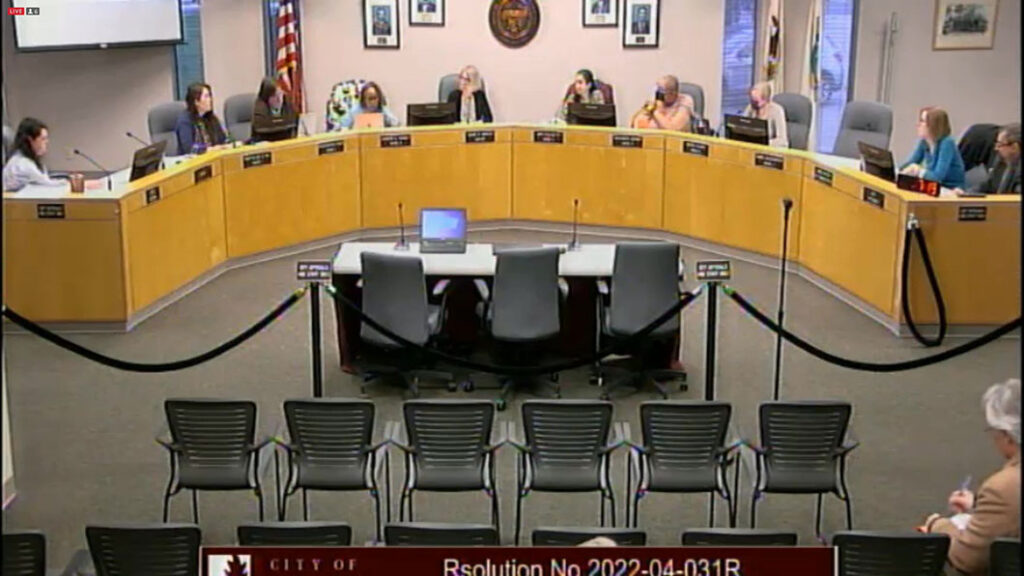
More than eleven months into their four year terms, the Urbana, Illinois City Council has finally agreed on a set of goals to work toward during 2022 and 2023.
After a number of failed attempts, the Council finally voted to approve a list of goals at their April 11th meeting. The approval came in the form of a resolution, which does not bind the Council or City staff to take any particular action, but it stands as a statement for things that they hope to work on.
Traditionally, Urbana City Council Resolutions have minimal follow-through and compliance, and tend to appear more as public relations efforts.
The list of goals is copied below, and the resolution in PDF formation, is provided below.
From Urbana City Council Resolution 2022-04-031R:
Strategic Area #1: Public Safety and Well-Being
Strategies:
- Pursue methods to mitigate community violence.
Action Steps
a) Fund community partners that address the root causes of community gun violence
b) Enhance City programs that address root causes of violence ( e.g., Self Made Kingz)
c) Identify and fund options that enhance current police investigative and operational capacity to
address community violence and solve serious crimes
i) Develop a proposal to increase the capacity of the Investigations Division of UPD
(staff/tech) to solve violent crimes - Enhance and expand public safety resources.
Action Steps
a) Contract for and complete a Public Safety Review
b) Develop a comprehensive safety plan, including funding requirements, based on the results and
recommendations of the Public Safety Review and available funding - Promote community well-being.
Action Steps
a) Fund and support community partners that promote health and wellness
b) Promote communication and outreach to individual neighborhood groups
c) Create a ‘manual’ for victims of violence that summarizes available support services in the C-U area
Strategic Area #2: Housing
Strategies:
- Support Housing security and equity.
Action Steps
a) Complete Home ARP Action Plan
b) Determine amount of ARPA funds to set aside to align with the identified needs and gaps in Home
ARP Action Plan
c) Coordinate with housing and social service agencies to reduce homelessness
d) Enhance compliance with the housing provisions of the Human Rights Ordinance by educating
landlords; increase awareness and understanding of the same with the community and tenants - Improve housing quality.
Action Steps
a) Pursue funds to rehabilitate dilapidated homes in targeted neighborhoods
b) Provide targeted assistance for home rehabs and repairs for seniors, persons with disabilities, and
low-income households
c) Prepare and review Consolidated Annual Performance Evaluation Report
Strategic Area #3: Infrastructure
Strategies:
- Improve quality of current infrastructure assets.
Action Steps
a) Develop asset management plan of existing infrastructure (lighting, traffic signals, sanitary system,
and bridges)
b) Develop plan for funding, level of service, and to replace/repair/build infrastructure (based on
assessment)
c) Update city infrastructure codes (subdivision/land development) - Increase investment in infrastructure equity.
Action Steps
a) Solicit community input for use of EQL funding
b) Implement EQL selected projects
c) Develop budget and strategy to take advantage of infrastructure grant funding for under-served areas
(prepare for grants for “shovel-ready” projects)
d) Incorporate an “equity lens” into priorities evaluation (begin with street lights, traffic, sanitary). - Expand Green infrastructure within the community.
Action Steps
a) Explore possible locations and funding for EV infrastructure
b) Evaluate options to enhance sustainability and climate resiliency on City-owned property and
facilities
c) Explore “green” fee revenue (ex: plastic bags) and green revolving funds
Strategic Area #4: Economic Recovery and Development
Strategies:
- Support current local businesses.
Action Steps
a) Expand small business pandemic support to non-traditional Urbana businesses (e.g., on-line, food
truck, mobile)
b) Survey local, minority-owned businesses to better understand their current challenges
c) Identify one or more sites Downtown* that the City will target for development with at least 50 units
of market rate housing [*Downtown: both sides and everything in between: Illinois, Race, University, and
Vine]
d) Enhance the Champaign Diversity Advancement Program (CDAP) to include more Urbana
minority, veteran and woman owned businesses
e) Merge together lists of Urbana businesses that currently exist and utilize that to work toward creating
a business registry that is updated annually
f) Study the challenges facing childcare providers in Urbana - Promote workforce development.
Action Steps
a) Explore the creation of an incentive program to encourage people to take retail, restaurant,
hospitality jobs (with partners, e.g., Parkland, RPC. .. ).
b) Collaborate with District #116 and Parkland College to develop a robust and unique marketing
program to enroll Urbana residents in the SWFf program.
c) Explore the creation of a Dual Credit Program modeled on Peoria (Fire/EMS/LE) - Recruit new businesses and industries.
Action Steps
a) Recruit a new hotel to the Cunningham Avenue corridor near I-74 to leverage the demand generated
by the Rantoul Sports Complex.
b) Create an incentive package and recruit a new grocery store and essential services to northwest
Urbana
c) Create an incentive package to attract a new cannabis dispensary that has a minority owner and
identify potential locations that are available for this use.
d) Identify Downtown destinations for Hotel Royer guests;
 Loading…
Loading…
